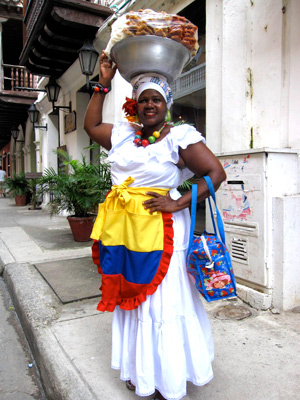Cartagena, Colombia Travel Guide
About Getting Around Attractions Essentials & Practicals
Intro to Cartagena

I loved Cartagena. It has history (tremendous history), walls you can climb, colorful colonial buildings, beautiful, exotic people, and great food. The only thing I regret for was not doing a gastronomy tour because I’m a foodie. Hey, I was on a budget.
Cartagena, Colombia was the first place I’ve ever traveled to in South America. Admittedly I was a little scared to visit due to Colombia’s history and reputation of drug cartels. And, I was going alone. But a co-worker mentioned that she once lived in Cartagena and it “is such a lovely place.”
My desire to visit Cartagena outweighed my fears. So off I went.
Cartagena is magical. My reservation of traveling to Colombia quickly dissipated (matter of fact, the Colombians who weren’t from Cartagena but were there to visit said that Cartagena wasn’t representative of Colombia).
Cartagena, known officially as Cartagena de Indias, is truly a place worth visiting. It’s the first Spanish colony and was founded in 1533 by Pedro de Heredia, a towering statue of whom I immediately saw when I entered the Old City (Ciudad Antigua, also known as Walled City or Ciudad Amurallada). Cartagena is also the birthplace and setting of the legendary literary novelist, Gabriel García Márquez.
A taxi ride from the airport cost me 10,000 Colombian pesos (and a 2,000 COP tip) to my hotel, Hotel Lee on Calle Larga (Calle 25). As an aside, the cab ride to Getsemani reminded me of my first trip to China where the driving and streets were a bit crazy. Pedestrians darted around cars to cross streets, and vendors slowly pushed their carts among cars and crowds. Actually I enjoyed the experience.
I immediately unpacked and wheeled north up Calle Larga (Calle 25), an extremely congested street with open-air shops, restaurants, often crumbly and weathered sidewalks and vehicles blocking some of the ramps. Took a right on Calle 24 towards the Old City’s Clock Tower Gate (Torre del Reloj). Before the clock tower, however, was the beautiful Camellón de los Mártires (just call it independence plaza) and Teatro Cartagena. The statues of historical figures and winged horses (Muelle de Los Pegagos) of plaza reassured me of my decision to travel to Cartagena.
I spent a most of my time wheeling around Getsemani and the fortified walls of the Old City. I also explored the neighboring La Matuna and even wheeled to Bocagrande (southwest). I felt safe wheeling around day and night.
At the south end of Camellón de los Mártires, I saw the impressive yellow Clock Tower, under which was the gateway to the Old City, at the north end. These areas (except Bocagrande) were lined with striking, pastel buildings with balconies and often elaborate columns revealing Cartagena’s colonial past, and plazas with lush, colorful floral arrangements.
Cartagena was a place to relax and explore. When I didn’t eat breakfast at my hotel, I got a pastry the local, El Pandequeso, in the Old City, and grabbed a single cup of tinto cafe from a street vendor for 300 COP. Then I just ventured into the streets where fruit and snack vendors, horse carriages, and crowds awaited. In the Old City were Colombian ladies wearing colorful traditional clothing while balancing fruit baskets on their heads. In the evenings I ate in the Old City and watched troupes give high energy and smiling performances of Mapalé Dance in the Old City’s Plaza de los Coches.
I of course did the tourist attractions: visited Cartagena’s museums, wheeled around the walls of the Old City, ventured around Castillo San Felipe de Barajas, and took in a breathtaking view of Cartagena atop La Popa.
Should you go to Cartagena? If you like history, culture, food, and awesome sights, absolutely! I found Cartagena to be a safe, lovely place.